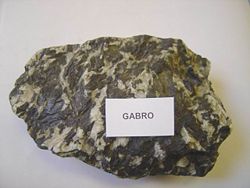Gabbro
Gabbro (IPA: /ˈgabrəʊ/) is a dark, coarse-grained, intrusive igneous rock chemically equivalent to basalt. It is a plutonic rock, formed when molten magma is trapped beneath the Earth's surface and cools into a crystalline mass.
The vast majority of the Earth's surface is underlain by gabbro within the oceanic crust, produced by basalt magmatism at mid-ocean ridges.
Petrology
Gabbro is dense, greenish or dark-colored and contains varied percentages of pyroxene, plagioclase, amphibole, and olivine (olivine gabbro when olivine is present in large quantities) The pyroxene is mostly clinopyroxene, small amounts of orthopyroxene may be present. If the amount of Orthopyroxene is substantially greater than the amount of clinopyroxene, the rock is then a Norite. Quartz gabbros are also known to occur and are probably derived from magma that was over-saturated with silica. On the other hand, essexites represent gabbros whose parent magma was under-saturated with silica, resulting in the formation of nepheline. (Silica saturation of a rock can be evaluated by normative mineralogy). Gabbros contain minor amounts, typically a few percent, of iron-titanium oxides such as magnetite, ilmenite, and ulvospinel.
Gabbro is generally coarse grained, with crystals in the size range of 1 mm or greater. Finer grained equivalents of gabbro are called diabase, although the vernacular term microgabbro is often used when extra descriptiveness is desired. Gabbro may be extremely coarse grained to pegmatitic, and some pyroxene-plagioclase cumulates are essentially coarse grained gabbro, although these may exhibit acicular crystal habits.
Gabbro is usually equigranular in texture, although it may be porphyritic at times, especially when plagioclase has grown earlier than the groundmass minerals.
Distribution
Gabbro can be formed as a massive uniform intrusion or as part of a layered ultramafic intrusions as a cumulate rock formed by settling of pyroxene and plagioclase. Cumulate gabbros are more properly termed pyroxene-plagioclase cumulate.
Gabbro is an essential part of the oceanic crust, and can be found in many ophiolite complexes as parts of zones III and IV (sheeted dyke zone to massive gabbro zone). Long belts of gabbroic intrusions are typically formed at proto-rift zones and around ancient rift zone margins, intruding into the rift flanks. Mantle plume hypotheses may rely on identifying similar massive gabbro intrusions and coeval basalt volcanism.
Uses
Gabbro often contains valuable amounts of chromium, nickel, cobalt, gold, silver, platinum, and copper sulfides.
Ocellar varieties of gabbro are often used as ornamental facing stones, paving stones and it is also known by the trade name of 'black granite', which is a popular type of graveyard headstone used in funerary rites.
Etymology
Gabbro was named by the German geologist Christian Leopold von Buch after a town in the Italian Tuscany region. Essexite is named after the type locality in Essex County, MA, USA.
See also
- Igneous rocks
- Cumulate rocks
External links
Template:Mineral-stub
cs:Gabro de:Gabbro et:Gabro es:Gabro fr:Gabbro ko:반려암 is:Gabbró it:Gabbro he:גברו lt:Gabras nl:Gabbro ja:ハンレイ岩 no:Gabbro pl:Gabro pt:Gabro ru:Габбро fi:Gabro sv:Gabbro
